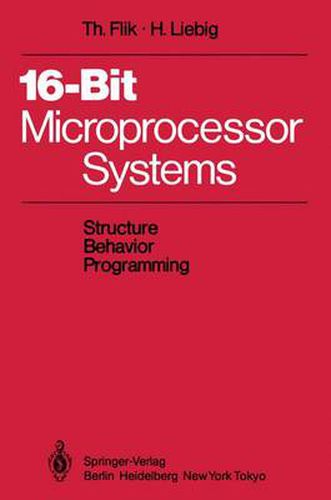Readings Newsletter
Become a Readings Member to make your shopping experience even easier.
Sign in or sign up for free!
You’re not far away from qualifying for FREE standard shipping within Australia
You’ve qualified for FREE standard shipping within Australia
The cart is loading…






This title is printed to order. This book may have been self-published. If so, we cannot guarantee the quality of the content. In the main most books will have gone through the editing process however some may not. We therefore suggest that you be aware of this before ordering this book. If in doubt check either the author or publisher’s details as we are unable to accept any returns unless they are faulty. Please contact us if you have any questions.
In the last few years, a large number of books on microprocessors have appeared on the market. Most of them originated in the context of the 4-bit and the 8-bit microprocessors and their comparatively simple structure. However, the techno-logical development from 8-bit to 16-bit microprossors led to processor components with a substantially more complex structure and with an expanded functionality and also to an increase in the system architecture’s complexity. This books takes this advancement into account. It examines 16-bit micro-processor systems and descrihes their structure, their behavior and their programming. The principles of computer or ganization are treated at the component level. This is done by means of a detailed examination of the characteristic functionali ty of microprocessors. Furthermore the interactions between hardware and software, that are typical of microprocessor technology, are introduced. Interfacing techniques are one of the focal points of these considerations. This puplication is organized as a textbook and is intended as a self-teaching course on 16-bit microprocessors for students of computer science and communications, design engineers and users in a wide variety of technical and scientific fields. Basic knowledge of boolean algebra is assumed. The choice of material is based on the 16-bit microprocessors that are currently available on the market; on the other hand, the presentation is not bound to anyone of these microprocessors.
$9.00 standard shipping within Australia
FREE standard shipping within Australia for orders over $100.00
Express & International shipping calculated at checkout
This title is printed to order. This book may have been self-published. If so, we cannot guarantee the quality of the content. In the main most books will have gone through the editing process however some may not. We therefore suggest that you be aware of this before ordering this book. If in doubt check either the author or publisher’s details as we are unable to accept any returns unless they are faulty. Please contact us if you have any questions.
In the last few years, a large number of books on microprocessors have appeared on the market. Most of them originated in the context of the 4-bit and the 8-bit microprocessors and their comparatively simple structure. However, the techno-logical development from 8-bit to 16-bit microprossors led to processor components with a substantially more complex structure and with an expanded functionality and also to an increase in the system architecture’s complexity. This books takes this advancement into account. It examines 16-bit micro-processor systems and descrihes their structure, their behavior and their programming. The principles of computer or ganization are treated at the component level. This is done by means of a detailed examination of the characteristic functionali ty of microprocessors. Furthermore the interactions between hardware and software, that are typical of microprocessor technology, are introduced. Interfacing techniques are one of the focal points of these considerations. This puplication is organized as a textbook and is intended as a self-teaching course on 16-bit microprocessors for students of computer science and communications, design engineers and users in a wide variety of technical and scientific fields. Basic knowledge of boolean algebra is assumed. The choice of material is based on the 16-bit microprocessors that are currently available on the market; on the other hand, the presentation is not bound to anyone of these microprocessors.